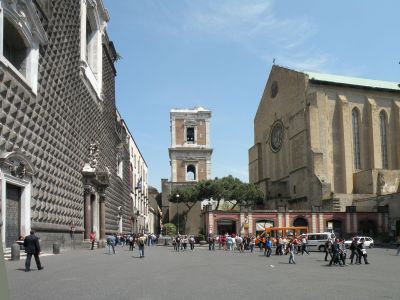The Basilica di Santa Chiara in Naples is a regal church. Not only for its elegance but also for the purpose of its construction: to house the bodies of the royal descendants of the Angiovin King, Roberto I, called “il Saggio” (“the Wise”). The Angiovin coat-of-arms incised in marble greets visitors walking up the main nave. In the early 14th century, Roberto became king after his brother, Saint Louis of Toulouse, a Franciscan saint, renounced the throne to enter the religious life.
The brothers are depicted in the most famous work surviving from the Angiovin court of Naples housed in the city’s Museo di Capodimonte. It is a ten-foot altarpiece by Simone Martini (1317-1319) in which Saint Louis wears a silver miter, richly-decorated gloves and cape and holds a gold crozier indicating his status as Bishop of Toulouse.
Under his magnificent ecclesiastical garb, he wears the rough wool habit of a Franciscan monk, a sign of poverty. The tunic shows that Louis’ ambition to become a Franciscan was successful as the young prince professed his vows just days before his ordination as Bishop of Toulouse in 1296.
The main panel of the Naples Simone Martini masterpiece depicts a double coronation: a pair of angels hold an elegant crown above Saint Louis’ head while the Saint holds a similar crown over his brother’s head as Robert kneels in submission to his right. The portrait of King Roberto I is the first ever done in Italy of a living personage, painted by Martini when the king was about 40-years-old.
In 1310, Roberto I and his second wife, the very devout Sancia di Majorca (who had hoped to enter the order of the cloistered Poor Clares), decided to erect a basilica just outside of Naples’ medieval walls, with an adjacent Franciscan monastery as well as a convent, thus creating a veritable monumental citadel. The church was initially dedicated to il Sacro Corpo di Cristo (“the Sacred Body of Christ”) or also called “Dell’Ostia Santa” (“of the Sacred Host”) inspired by the Eucharistic miracle of Bolsena in 1263. The church opened for veneration by the faithful in 1336.
The tomb of Roberto I takes center stage in the church he commissioned, just behind the altar. Side chapels flank the high altar backed by the King’s tomb, sculpted by Florentine brothers and architects, Giovanni and Pacio Bertini, in the mid-14th century. A sculpted crucifix hangs in front of the tomb. Work had started in 1310, concluding in 1328 under the direction of Napoletano architect Gagliardo Primario who created the largest Gothic church in Naples and one of the most impressive Angiovin monastic buildings in the city.
The Santa Chiara monumental citadel includes four grandiose cloisters as well as subterranean archaeological excavations, for this had probably been the site of Roman baths. Even before it was completed, the church housed venerated relics including those of Saint Louis of Toulouse, elder brother of King Roberto I. One was the brain of St. Louis in an elegant, ornate reliquary adorned with a crown, donated by Queen Sancia in honor of her brother-in-law.
The rulers of the Angiovin dynasty as well as the most important dignitaries of court were buried in the Basilica and subsequently the Bourbon rulers also. For more than four centuries, the complex of Sant Chiara remained as the Angiovins had conceived it.
In the mid-18th century, architects Ferdinando Sanfelice and Domenico Vaccaro with a group of decorators and architects were commissioned to add Baroque embellishments, thus “modernizing” the architecture of one of Naples most important churches. At this time, Naples was the most important and economically advanced city in Italy, four times bigger than Rome and twice as big as Milan, and larger than New York and Tokyo.
On August 4, 1943, Allied bombs devastated the church, with fires raging for two days. After 10 years of painstaking restoration which returned Santa Chiara to its medieval aspect, the church re-opened in 1953. Fortunately, WWII devastation had spared some of the elegant medieval tombs located in the various side chapels; others were damaged but skillfully restored.
Naples’ largest gothic church and adjoining monastery share just some of the rich history the southern city has to offer.
https://www.lagazzettaitaliana.com/travel/10257-naples-basilica-di-santa-chiara#sigProId794e8c8139




